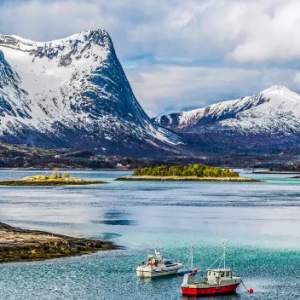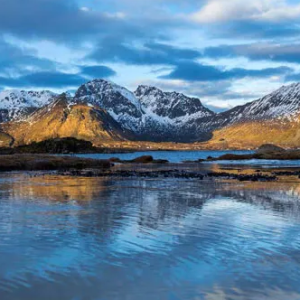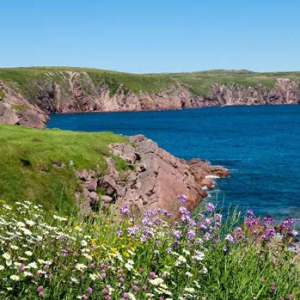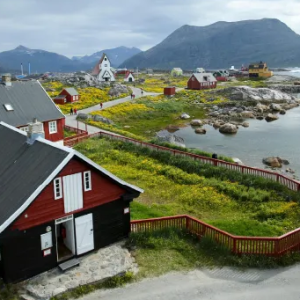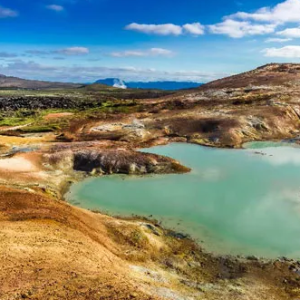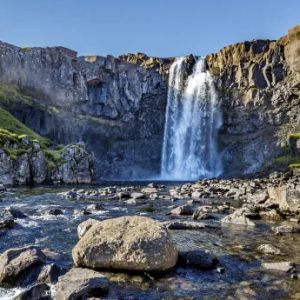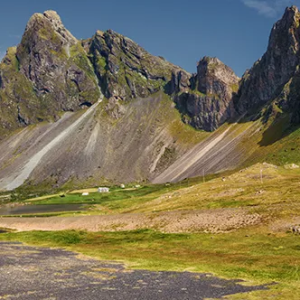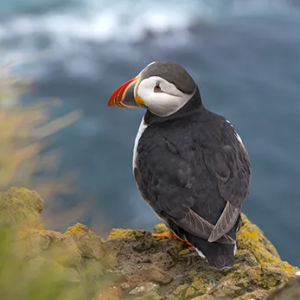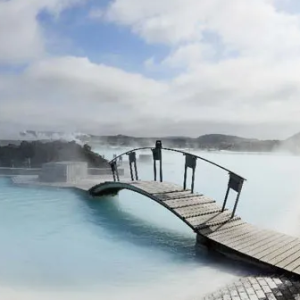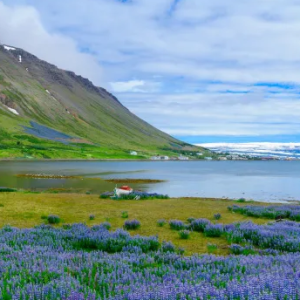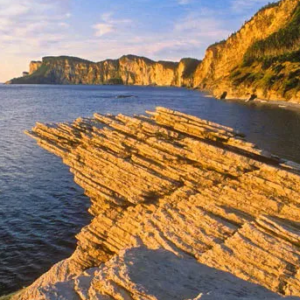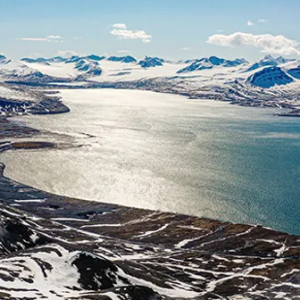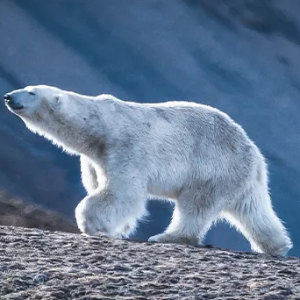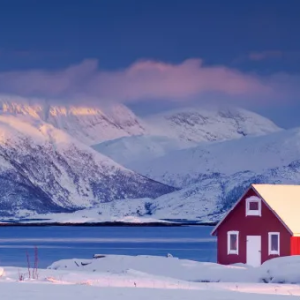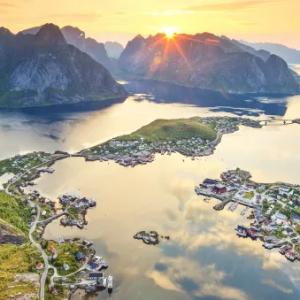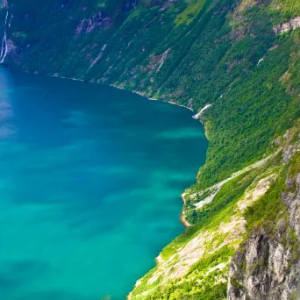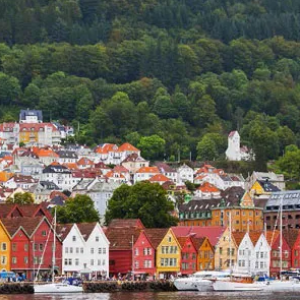Greenland, Iceland, Norway & Beyond
Viking Ocean Cruises | 29 Days | Bergen to New York City
June - August 2026 Departures
Traverse the far northern seas to Canada, Greenland, Iceland and the Arctic, and discover distant shores. Follow in the wake of intrepid explorers through Norway and Svalbard, and circumnavigate Iceland as you experience nature at its most magnificent. From quaint fishing villages to snowcapped mountaintops, witness majestic landscapes, and sail to the New World to learn about Inuit traditions as you revel in the history of Viking exploration.
AAA Member Benefits and Special Offers:
- Member Benefits
- $200 per person shipboard credit
Viking Inclusive Value
- One complimentary shore excursion in every port of call
- Free Wi-Fi (connection speed may vary)
- Beer, wine & soft drinks with onboard lunch & dinner
- 24-hour specialty coffees, teas & bottled water
- Port taxes and fees
- Ground transfers with Viking Air purchase
- Visits to UNESCO Sites
- Enrichment lectures & Destination Performances
Day 1: Bergen, Norway
Embark your ship and settle into your stateroom. Bergen is home to the Hanseatic League’s onlykontor (trading enclave) still in existence. Bryggen wharf, a row of timbered Hanseatic warehouses along a quaint quay, is a UNESCO World Heritage Site. Narrow wooden walkways are flanked by parallel rows of small, vibrantly painted buildings overlooking the picturesque Vågen Harbor. This is perhaps the most charming district of Bergen and a delight to explore, from its tight-knit community of workshops where artisans sell their wares to its cafés where freshly preparedsmørbrød, or open-faced sandwiches, are on the menu.
Day 2: Bergen, Norway
Bergen, an ancient city with deep Viking roots, is located in the heart of western Norway, nestled between seven gargantuan mountain peaks. It is also the gateway to the country’s magnificent fjords, including the Hardangerfjord and Sognefjord. Founded in 1070 on what was a Viking settlement, Bergen was Norway’s capital during the 13th century; today, it is the second-largest city in Norway. Not to be missed is a stroll through the picturesque outdoor fish market, Fisketorget, where the fresh catch of the sea awaits—from cod and prawns to local caviar and icy oysters.
Day 3: Geiranger, Norway
Geiranger is the gateway to some of coastal Norway’s most magnificent natural treasures. Nearby, the Seven Sisters Waterfall tumbles 1,000 feet into the fjord’s water, while directly across the fjord, the Suitor Waterfall also plunges down a steep face. The overlook known as Eagle’s Bend towers 2,000 feet above the village, accessed via a winding mountain road with 11 hairpin turns. The Norwegian Fjord Center puts all this natural splendor into perspective with fascinating exhibits.
Day 4: Scenic Sailing the Norwegian Inside Passage
The Norwegian Inside Passage is a protected shipping lane that runs from Norway’s capital of Oslo, down the Skagerrak coast and around the country’s southern tip. It continues north along the coastline of the Norwegian Sea, before eventually terminating in the Russian waters of Siberia. It has been used by mariners for centuries, its channels protected from the dangers of the open water by countless skerries and the rugged coastline presenting opportunities for shelter in its many natural bays and inlets.
Day 5: Narvik, Norway
Narvik is situated on the innermost shores of the Ofotfjorden, within the Arctic Circle. The small town enjoys a dramatic backdrop, encircled by mountains and a glacier that spills right to the water’s edge. The town served as a port city for the early Viking settlers. Much later, the discovery of iron ore in the nearby Swedish town of Kiruna forever shaped Narvik. Kiruna needed a year-round ice-free port from which to ship its new discovery, and so a rail link was built directly to the water. Still today, Narvik is a major exporter.
Day 6: Lofoten, Norway
The Lofoten Islands stretch 118 miles into the Norwegian Sea from Norway’s coast. Ships in the archipelago’s cozy fishing harbors are dwarfed by the hulking massifs rising from the waters. The setting was ideal for Norse settlements in the early Viking Age. Cod has long been harvested from these waters as they come here to spawn. More recently, the fish have been caught from traditionalrorbus, charming cottages that hover above the waters on stilts. The Lofoten Islands are beautiful any time of year, but the summertime midnight sun illuminates their magnificent glory.
Day 7: Tromsø, Norway
Tromsø is Norway’s most northerly city and has long been considered the gateway to the Arctic. During the summer months, pretty wooden houses exude an air of sophistication as they bask beneath the glow of the Midnight Sun. Winter brings pristine landscapes surrounded by snowcapped peaks and the aurora borealis, whose magical lights dance across the nighttime skies. World-renowned explorers have set sail from Tromsø’s shores; Roald Amundsen, Norway’s first son and the first explorer to reach both poles, is commemorated with a bronze statue in the city.
Day 8: Honningsvåg, Norway
Honningsvåg overlooks a pristine bay of the Barents Sea on Magerøya Island. This unassuming enclave grew mainly on the fishing industry, like so many in this remote region. Honningsvåg has ample charms, including a rich Sami culture and a deep love of the birdlife that lives here. But it is the surrounding beauty that draws visitors: starkly beautiful tundra dotted with mountain birch trees, distant rocky islands and rolling slopes that ascend into mountains. One of Europe’s most stunning natural sights, Nordkapp, or North Cape, rises on the island’s rugged northern coast.
Day 9: Sail the Barents Sea
Named for 16th-century Dutch navigator and polar explorer Willem Barentsz, the Barents Sea is the gateway to the Arctic from the northernmost shores of Europe and home to an astonishing diversity of marine life. Renew your body, mind and spirit in our Scandinavian-inspired Spa, a Nordic sanctuary of holistic wellness, today while at sea. Whether you unwind in the Sauna, refresh in the Snow Grotto or take a dip in the Thermal Pool, you will feel recharged and revitalized.
Day 10: Longyearben, Svalbard and Jan Mayen Islands
Svalbard’s setting is marked by stunning fjords, mountain peaks and thick glaciers that have formed over millennia, while Alkhornet mountain and its looming cliffs date back more than one billion years. Wildlife flock to this stark landscape during the summer—puffins, polar guillemot and kittiwake descend en masse each year. The Svalbard Museum showcases the vast array of special plant and animal life that reside here, as well as everyday life for its human residents, from the arrival of the whalers during the 17th century to present-day miners.
Day 11: Longyearben, Svalbard and Jan Mayen Islands
Explore the stunning beauty of the Svalbard archipelago, hundreds of Norwegian islands halfway between Norway and the North Pole. Stunning panoramas unfold here—dramatic fjords lead into glimmering bays surrounded by massive glaciers and rugged peaks cloaked in snow. The austere tundra unfolds to an Arctic desert where polar bear, Arctic fox and reindeer roam. Many regions have been designated Important Bird Areas by BirdLife International for the countless winged creatures that breed and hunt along the coast. Its endless wonders can be explored by zodiac, kayak and land.
Days 12-13: Sail the Norwegian Sea
Journey to what was once believed to be the “end of the world,” where sea monsters lurked and ships were lost on treacherous waters. As you sail today, savor a range of international cuisine on board. Choose from a variety of international flavors at the World Café, enjoy al fresco dining on the Aquavit Terrace, or regional specialties in The Restaurant.
Day 14: ĺsafjördur, Iceland
ĺsafjördur was founded in the 9th century by the Viking Helgi Magri Hrólfsson. Foreign merchants arrived in the 16th century and set up trading posts here. Today, ĺsafjördur is home to one of the largest fisheries in Iceland and, despite its remote locale, boasts a cultural scene rich in music and drama. The oldest house in Iceland is here, built in 1734, as is the country’s largest concentration of old timber-frame homes. Many visitors explore farther afield, delving into the surrounding wilderness of Hornstrandir or discover the fishing heritage of charming coastal towns.
Day 15: Reykjavík, Iceland
Reykjavík is the world’s northernmost capital city yet captures the distinctive feel of a fishing village. The Kentucky-sized island is Europe’s westernmost nation and one of the wildest places on earth. It is also lauded as one of the cleanest and most civilized countries, committed to finding the perfect balance between day-to-day living and harnessing its natural resources with eco-friendly practices. Vikings landed on this pristine land during the 9th century; their arrival is well chronicled in the medieval Sagas preserved at the Culture House.
Day 16: Heimaey, Iceland
Heimaey is the only populated island in the Westman Islands. The scenery is stunning with its volcanic landscapes, moss-covered clifftops and picturesque homes with brightly colored rooftops. A number of breathtaking natural sights are a result of the volcanic eruption that took place here in 1973, which saw the evacuation of all 5,000 residents to the mainland. Each summer, millions of puffins pay a visit and countless other species migrate here to feed and breed. Several efforts are underway to protect the wealth of wildlife, from puffins to the gentle giants of the sea.
Day 17: Djúpivogur, Iceland
Djúpivogur lies on Iceland’s east coast and has been a trading center since the 16th century. The town is presided over by the towering Búlandstindur; a mountain famed in local folklore for its ability to grant wishes during the summer solstice. Dotted around the town, several cultural sights can be explored, including The Tank and the Eggs of Merry Bay. Residents here favor embracing a slower pace of life. The town has adopted the cultural trend known as “Cittaslow” which is dedicated to the promotion of sustainable living, improving the quality of life for its residents.
Day 18: Seydisfjördur, Iceland
Seydisfjördur enjoys a mountainous setting at the end of a fjord. It traces its origins to the early days of Viking settlements. Though the town is tiny, it boasts an impressive history. It hosted the world’s first modern whaling station and pioneered international communications when it welcomed the first telegraph cable, linking Iceland to Europe. Colorful wooden homes line the streets, overseen by starkly picturesque slopes and the soaring summits of Mounts Bjólfur and Strandartindur.
Day 19: Akuryeri, Iceland
Nicknamed the “Capital of the North,” Akureyri is set at the end of the Eyjafjördur and enjoys a mild climate, unusual for a northern city just 62 miles from the Arctic Circle. Folk culture is robust in Akureyri; the Vefarinn dance was invented here to celebrate the harvest. Other points of pride include the Public Park and Botanic Garden, where some 2,000 plant species grow, and the hilltop Akureyrarkirkja, the local church that is home to a stained glass window that originated in a church in London, England, prior to World War II.
Day 20: ĺsafjördur, Iceland
Ísafjördur, nestled at the foot of dramatic mountain slopes, is the capital and largest settlement on the Westfjords, a large peninsula in northwestern Iceland that is connected to the mainland by a wide isthmus. This rugged, unspoiled region is home to landscapes of breathtaking natural beauty, from jagged mountain peaks, to red- and gold-sand beaches, cascading waterfalls and Drangajökull, Iceland’s only expanding glacier. The Westfjords teem with birdlife; Látrabjarg, located on the peninsula’s western shores, is the site of one of Europe’s largest bird cliffs.
Day 21: Sail the Atlantic Ocean
Day 22: Nanortalik, Greenland
Nanortalik is nestled on an island near the mouth of a fjord on the southwestern shores of Greenland. It was established in 1770, though a small group of Vikings led by Erik the Red first arrived in the 10th century and called it “Grœnland,” or Greenland, in hopes of attracting more settlers. Today, the Inuit people dominate this austere and picturesque landscape and hold fast to their long Inuit traditions by fishing for crab, hunting hooded seals and welcoming visitors with a festivekaffe-mik, a coffee party with plenty of their famed Greenlandic cake.
Day 23: Qaqortoq, Greenland
Qaqortoq is a repository of Viking, Inuit and Danish history. Greenland’s largest and best-preserved Viking settlement lies 12 miles out of town at Hvalsey, established by Erik the Red’s uncle in the 10th century. The Inuit soon followed, and left behind many artifacts from their early days. The Danish colonial era, too, is finely reflected in historic buildings, including an 1804 blacksmith’s shop and the harborside 1797 black tar log building. Qaqortoq lends itself to leisurely strolls and its spectacular setting attracts outdoor enthusiasts.
Day 24: Sail the Labrador Sea
Follow in the footsteps of intrepid Viking Leif Eriksson who famously crossed this stretch of water to become the first European to land on North American shores.
Day 25: L’Anse aux Meadows, Newfoundland and Labrador, Canada
L’Anse aux Meadows is the site of the first Norse settlement in the Americas. Leif Eriksson’s voyage from Greenland in the late 10th century predated Columbus by 500 years. Proclaimed a UNESCO World Heritage Site in 1978, the ancient village Eriksson founded provides fascinating insight into the day-to-day lives of Vikings. Each of its dwellings was constructed of a wood frame covered in sod. The site was uncovered in 1960, when a village local pointed out a series of mounds in the earth that he and his neighbors had always believed to be an ancient Native American camp.
Day 26: Sail the Gulf of St. Lawrence
Follow in the footsteps of 10th-century Vikings and sail the vast Gulf of St. Lawrence, an outlet for the North American Great Lakes into the Atlantic Ocean via the St. Lawrence Seaway.
Day 27: Halifax, Nova Scotia, Canada
Halifax exudes a fine European air and lies along the edge of the Atlantic Ocean. Visitors by sea are greeted by the 1758 Sambro Island Lighthouse, the oldest surviving beacon in North America. In the harborside Historic Properties district, grand and charming stone buildings built in the 18th and 19th centuries grace the cobblestone streets. The city grew up around Citadel Hill, where Fort George protected the harbor. The fortress, along with the adjacent stately Halifax Town Clock, has been gloriously restored and preserved.
Day 28: Sail the Atlantic Ocean
Day 29: New York City, New York
Bid farewell to your fellow guests and journey home. Or spend more time exploring, perhaps joining one of Viking's extensions.
All pricing and offers for accommodations and other non-air travel are per person, based on double occupancy, capacity controlled and subject to availability and change without notice. Pricing does not include taxes, fees, fuel surcharges, gratuities, resort fees, or airfare unless otherwise noted and is valid on new bookings only. Prices, fees, and other restrictions are subject to supplier policies. All offers, including but not limited to, bonus amenities, upgrades, prices, and group benefits are based on select dates, resorts, room categories, and/or fare codes. Specialty pricing may require proper identification. Cancellation penalties, blackout dates, and other restrictions may apply. When traveling outside the United States a valid passport is required. It is the sole responsibility of the passenger to have the proper documentation and identification required by the United States and other governments at the time of travel. When passports are required, it must be valid for a minimum of six months past your date of return. AAA strongly recommends the purchase of Travel Insurance. Usage of a credit card for travel arrangements may provide additional protection, please consult your credit card policies. Under certain circumstances the package price may be subject to supplemental price increases imposed by the supplier. Price increases include, but are not limited to fuel surcharges, taxes or fluctuations in foreign exchange markets that may be imposed after the date of purchase. Air-inclusive prices do not include government imposed taxes and fees, including but not limited to a September 11th Security Fee, U.S. or international government imposed taxes and fees, Federal Excise Fees, among others. Some carriers charge additional fees for checked bags, fuel surcharge, meals, etc. Please check the carriers website for details. Air-inclusive pricing is based on select departure cities. Prices from other cities may vary. AAA Oregon/Idaho acts solely as a sales agent for travel suppliers and is not responsible for the actions or inactions of such suppliers. We monitor all of the information presented on our website; however, we do not assume responsibility for any errors or omissions in the content of the offers displayed. Review full Travel Disclosure and Consent at time of booking.
AAA
Member Benefit:
$100 per person shipboard credit for all Viking voyages 8-11 days. $200 per
person shipboard credit for all Viking voyages 12 days or longer. Shipboard
credits can only be applied when booked directly by AAA Travel Agent. This
offer is combinable with group rates, early booking discounts, past passenger
discounts, refer a friend credits and future cruise vouchers. Offer is not
combinable with interline and wholesale bookings or valid on other Viking
products. Onboard credit has no cash value. Viking reserves the right to
correct errors and to change any and all fares, fees and surcharges at any
time. CST# 2052644-40
 Click Here to View Your Vacation
Click Here to View Your Vacation
